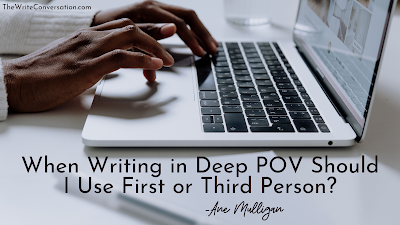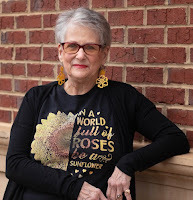When Writing in Deep POV Should I Use First or Third Person?

by Ane Mulligan @AneMulligan
I started writing my first book in 3rd person. My first 4 published books were in 3rd person. I learned to write in deep POV, taking my readers inside my character's head, and allowing them to go on the journey with him or her.
Then, something changed.
When I started In High Cotton , as I wrote the backstory, it came out in first person. And I loved it. Yes, there are certain constraints to writing first person, but it felt right.
Interestingly, I hadn't sold my first book yet, so I went back and rewrote the first couple of chapter in first person. Then, I sent it to my critique partners, asking them what they thought. Their reaction gobsmacked me.
They said that story was more intimate in third person because of the deep POV.
I learned something that day. Stories dictate how they want to be told. Here's another surprise: first person doesn't necessarily mean deep POV. The same "telling" words need to be watched. It's easy to think I can write:
I wondered if she'd tell everyone my secret.
However, better and deeper POV would be:
Is she going to tell my secret?
And yet another way that would work:
I know her. I never should have told her. She's going to blab it all over town. How could I have been so stupid?
Telling vs showing come into play when writing deep POV. You've got to write WHAT your character thinks, sees, and experiences from inside their head. That's how your readers will feel like they are inside the story.
From my WIP, Listen To Your Heart:
It’s tech week—that strength-sucking, sleep-robbing, hair-pulling five days of working out all the bugs from a production before opening night. Five loooonnng days, when I wish we had another month.
I hate it.
And I love it.
A small tweak can bring this deeper:
It’s tech week—that strength-sucking, sleep-robbing, hair-pulling five days of working out all the bugs from a production before opening night. Five loooonnng days. Egads, I need another month.
I hate it.
And I love it.
Here's a third person example:
Of all the days to be late. Claire Bennett stormed up the boardwalk toward Dee's 'n' Doughs. Any other day, the storefronts with their brightly striped awnings, created a cherry rainbow on Sandy Shores Drive. Not today. Skullduggery was afoot in Chapel Springs.
Having a number of books under my belt now, I would tweak that like this:
Of all the days to be late. Claire Bennett stormed up the boardwalk, her sights set on Dee's 'n' Doughs. Any other day, the colorful storefronts were a rainbow of cheer. She squinted. Not today. Skullduggery was afoot in Chapel Springs.
A small change, but one that keeps it deep in Claire's POV.
Deep POV takes work, but when you master it—or at least have a good handle on how it's done (do we ever master this craft?) it lets your readers experience the story with your character.
TWEETABLEWhen Writing in Deep POV, Should I Use First or Third Person? @AneMulligan on @EdieMelson (Click to Tweet)
 Ane Mulligan lives life from a director’s chair, both in theatre and at her desk creating novels. Entranced with story by age three, at five she saw PETER PAN onstage and was struck with a fever from which she never recovered—stage fever. One day, her passions collided, and an award-winning, bestselling novelist emerged. She believes chocolate and coffee are two of the four major food groups and lives in Sugar Hill, GA, with her artist husband and a rascally Rottweiler. Find Ane on her website, Amazon Author page, Facebook, Instagram, Pinterest, The Write Conversation, and Blue Ridge Conference Blog.
Ane Mulligan lives life from a director’s chair, both in theatre and at her desk creating novels. Entranced with story by age three, at five she saw PETER PAN onstage and was struck with a fever from which she never recovered—stage fever. One day, her passions collided, and an award-winning, bestselling novelist emerged. She believes chocolate and coffee are two of the four major food groups and lives in Sugar Hill, GA, with her artist husband and a rascally Rottweiler. Find Ane on her website, Amazon Author page, Facebook, Instagram, Pinterest, The Write Conversation, and Blue Ridge Conference Blog.
Published on October 27, 2024 22:00
No comments have been added yet.



